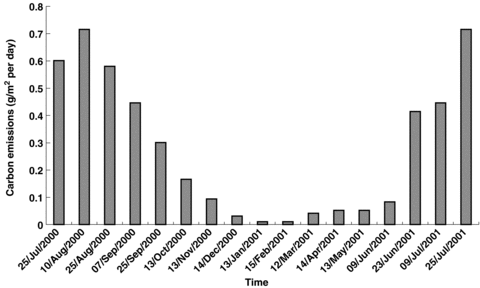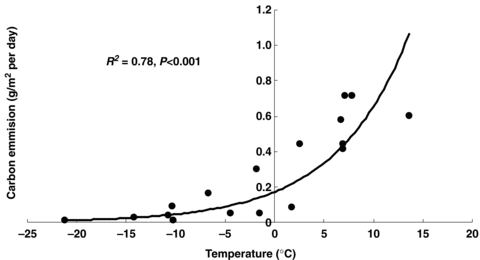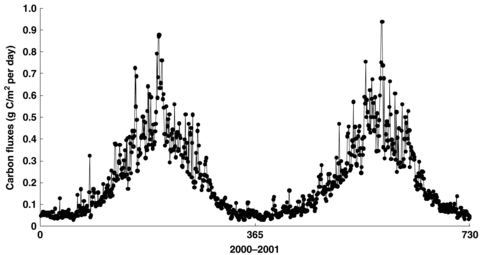Carbon Balance in an Alpine Steppe in the Qinghai-Tibet Plateau
Supported by the National Basic Research Program (2005CB422005), and the Pre-studies Project of National Basic Research Program (2005CCA05500).
Abstract
Carbon fluxes were measured using a static chamber technique in an alpine steppe in the Qinghai-Tibet Plateau from July 2000 to July 2001. It was shown that carbon emissions decreased in autumn and increased in spring of the next year, with higher values in growth seasons than in winters. An exponential correlation (Ecarbon= 0.22(exp(0.09T) + ln(0.31P+ 1)), R2= 0.77, P < 0.001) was shown between carbon emissions and environmental factors such as temperature (T) and precipitation (P). Using the daily temperature (T) and total precipitation (R), annual carbon emission from soil to the atmosphere was estimated to be 79.6 g C/m2, 46% of which was emitted by microbial respiration. Considering an average net primary production of 92.5 g C/m2 per year within the 2 year experiment, alpine steppes can take up 55.9 g CO2-C/m2 per year. This indicates that alpine steppes are a distinct carbon sink, although this carbon reservoir was quite small.
It is well known that increases in atmospheric concentrations of greenhouse gases are responsible for global warming (Tett et al. 1999; Crowley 2000). Among all the greenhouse gases in the atmosphere, carbon dioxide (CO2) is the most abundant gas and contributes almost 50% of all greenhouse forcing (Lashof and Ahuja 1990; Rodhe 1990). The concentration of atmospheric CO2 has increased from 280 parts per million by volume (p.p.m.v.) since pre-industrial times (pre-1800) to 380 p.p.m.v., increasing at the rate of 3 p.p.m.v. per year (Neftel et al. 1985; Friedli et al. 1986; Fans et al. 1998; Monnin et al. 2001). Besides anthropogenic changes, a large amount of carbon (C) is fixed into the biosphere from the atmosphere via plant photosynthesis and subsequently released from biota to the atmosphere by respiration or burning of plants. So, the release of CO2 from terrestrial biota has contributed significantly to the atmospheric CO2 concentration (Sommerfeld et al. 1993).
The Qinghai-Tibet Plateau is the so-called “third pole” of the earth with a mean altitude of more than 4000 m above sea level. Great uplift of the plateau created and then strengthened the South Asian monsoon, and has a tremendous impact on the development of physical environments and ecosystems (Zheng and Zhu 2000). Due to the topographic features and the characteristics of the atmospheric circulation, typical alpine zones of forests, meadows, steppe and deserts appear in succession from southeast to northwest in the plateau (Zheng et al. 1979).
Alpine steppe ecosystems cover a large area of the whole plateau. They are very sensitive to climate change and anthropogenic activities. Several studies have explored the C exchange in alpine meadows and shrubs in the Qinghai-Tibet Plateau (Xu et al. 2006; Zhao et al. 2007; Hu et al. 2008), but few have been carried out in alpine steppes. The objectives of the present study were: (i) to measure CO2 flux between soil and atmosphere in the field; (ii) to establish the relationship between C emission and environmental factors such as temperature and precipitation; and (iii) to estimate the C balance in alpine steppes. Integrating these data, we hope to discover the role of alpine steppes in the C budget.
Results
Soil physical and chemical properties
The alpine steppe soil at the study site had a light texture (sandy loam), and the other physical and chemical characteristics of surface soil are presented in Table 1. Higher C storage was found in the 10–20 cm depth of this sandy loam soil. Soil moisture increased with depth because of the strong evaporation in this region. Soil pH decreases gradually with increasing soil depth.
| Depth (cm) | Moisture (%) | pH | Organic C (%) | Total N (%) |
|---|---|---|---|---|
| 0–10 | 3.61±1.06 | 9.02 ± 0.23 | 0.15 ± 0.05 | 0.04 ± 0.005 |
| 10–20 | 5.05 ± 2.82 | 9.03 ± 0.16 | 0.15 ± 0.02 | 0.04 ± 0.004 |
| 20–30 | 7.28 ± 2.15 | 8.90 ± 0.21 | 0.32 ± 0.04 | 0.07 ± 0.004 |
Vegetation characteristics
The biomass was a bit lower than other grasslands in the plain regions. The ratio of biomass between below-ground and above-ground was more than 14:1. The C concentration in the green part was higher than litter and root parts (Table 2).
| Biomass (g/m2) | Plant C (%) | Total N (%) | |
|---|---|---|---|
| 2000 | |||
| Green | 44.55 ± 16.25 | 38.88 ± 1.31 | 1.02 ± 0.13 |
| Litter | 1.24 ± 0.39 | 34.44 ± 4.64 | 0.70 ± 0.11 |
| Root | 668.75 ± 227.3 | 27.70 ± 3.97 | 0.86 ± 0.16 |
| 2001 | |||
| Green | 56.48 ± 17.84 | 39.90 ± 3.08 | 1.99 ± 0.35 |
| Litter | 8.46 ± 1.44 | 36.93 ± 6.13 | 0.94 ± 0.24 |
| Root | 1117.14 ± 141.94 | 22.39 ± 3.87 | 0.99 ± 0.10 |
Net primary production
Based on Table 2, the above-ground net primary productivity (NPP) was estimated to be 17.32 g C/m2 per year in 2000 and 22.53 g C/m2 per year in 2001. Because below-ground net primary productivity occupied almost one third of the whole root biomass for alpine meadows (GM Cao, pers. comm., 2004), the below-ground NPP in alpine steppes was estimated to be 61.75 g C/m2 per year in 2000 and 83.38 g C/m2 per year in 2001.
CO2 emission
CO2 emissions showed a clear seasonal variation, decreasing in autumn and increasing in spring (Figure 1). CO2 emissions during the growth seasons were much higher than those during the non-growth seasons. The highest mean CO2 emission occurred in August. Root respiration and microbial respiration were the main source of soil CO2. In the present study, CO2 emissions had a pattern similar to the variation of temperatures. It was shown that the variation in CO2 emissions was positively related to air temperatures (Figure 2).

Soil respiration (g C/m2 per day) in alpine steppe at Wudaoliang on the measuring days in 2000 and 2001.

Relationship between soil respiration (g C/m2 per day) and air temperatures (°C) in alpine steppe of Wudaoliang.
 (1)
(1)Based on Equation 1, continuous CO2 emissions from 2000 to 2001 were estimated and shown in Figure 3. Annual C emission was 79.97 g C/m2 for 2000 and 79.24 g C/m2 for 2001.

Estimated soil respiration (g C/m2 per day) in alpine steppe at Wudaoliang, calculated from daily air temperature and precipitation based on Equation 1.
C balance
Carbon exchanges between atmosphere, land and the oceans play an important role in regulating the global carbon cycle and balance. The net carbon exchange of terrestrial ecosystems is the result of a balance between uptake (photosynthesis) and loss (respiration). Soil respiration is derived from both root respiration and the respiration of soil organic matter by heterotrophs (Andrews et al. 1999). According to some previous studies, the CO2 production by respiration activity in soil originating from soil organic matter (microbial respiration) contributes 45%–48% of soil respiration in grassland ecosystems (Kelting et al. 1998; Rochette et al. 1999; Hu et al. 2008). So in our study area, annual CO2 emission derived from microbial respiration was estimated to be about 36.79 g/m2 in 2000, and 36.45 g/m2 in 2001. In natural ecosystems, carbon inputs via litterfall and fine root turnover are the final plant primary production. In our experiment, estimates of the NPP during the 2 year experiment were 79.07 and 105.91 g/m2 per year. This indicates that alpine steppes can take up 42.28 g CO2-C/m2 in 2000 and 69.46 g CO2-C/m2 2001.
Discussion
In these kind of alpine steppes, the ratio of biomass between below-ground and above-ground was over 14:1, higher than other plain areas (12:1, Chen and Wang 2000). The vegetation root system here was stronger than in the plain area due to low soil water content. NPP in the alpine steppe was about 79.50 g C/m2 in 2000 and 109.02 g C/m2 in 2001. These values were lower than temperate steppes in Inner Mongolia (189.2 g C/m2 per year, Xiao et al. 1996). A possible explanation is that plant growth in alpine steppes is limited by lower temperature and less precipitation, as well as barren soils.
Total soil respiration from alpine steppes at Wudaoliang was estimated to be 79.97 g C/m2 in 2000 and 79.24 g C/m2 in 2001, respectively. These values were lower than those from temperate grasslands in Inner Mongolia (Dugas et al. 1999; Dong et al. 2000; Mielnick et al. 2001) and from alpine meadows in the Qinghai-Tibet Plateau (Wu et al. 2005; Zhang et al. 2005). Two possible explanations can be proposed. First, biomass, soil substrate as well as climatic factors influence soil respiration. It has been shown that annual soil respiration rates correlate well with the biomass of different vegetation biomes (Raich and Schlesinger 1992). Besides, numerous studies have showed that soil respiration is positively related to soil total C and N content (Frank and Groffman 1998). In the present study the biomass, soil organic C and total N, annual temperature, and annual precipitation were lower than other grasslands (Dong et al. 2000; Mielnick et al. 2001; Ross et al. 2001). This partly accounts for why soil respiration rates in the alpine steppe are lower than other grasslands. Second, soil pH values have an impact on soil respiration, for example, Xu and Qi (2001) showed that CO2 efflux was negatively correlated with soil pH values. In the present study the soil pH value was a little higher than in other grasslands.
The C balances in our study area were 42.28 g C/m2 in 2000 and 69.46 g C/m2 in 2001, with an average of 55.47 g C/m2 per year. This indicates that alpine steppe was a CO2 sink, although net C sequestration was very small. The mysterious missing C sink has become a great issue in ecological sciences for decades. Recent studies have suggested that the Northern Hemisphere land areas (especially the forests) are functioning as a significant C sink (Fang et al. 2001; Schimel et al. 2001). Tropical land areas were approximately in balance with respect to C exchange, implying a C sink that offset emissions due to tropical deforestation. However, Schindler (1999) suggested that the missing sink may be several smaller sinks. Our study area is also located in the northern hemisphere, and contributes as a small reservoir. Alpine steppe ecosystems may also be important in C uptake in addition to forest ecosystems in the northern hemisphere.
Materials and Methods
Site description
The study site was located in Wudaoliang, Qinghai Province, China (35.13°N, 93.05°E). The altitude of the study site is 4 767 m above sea level. The area has no human activity, so it is an ideal place to investigate the mechanism of carbon flux. This area is characterized by a sub-frigid and semiarid climate. Average monthly air temperature was below 0 °C except during the growth season, and mean annual temperature was −5.6 °C (Sun and Zheng 1998). Annual mean precipitation ranged from 200 mm to 400 mm, with 84% occurring in the growth season (from June to September). The soil type was the alpine steppe soil. Permafrost can be found in this region. The ecosystem was classified as an alpine steppe, and the study site was dominated by Stipa purpurea (Zheng et al. 1979). The leaf area index was about 0.63 (TX Luo, pers. comm., 2004).
Soil and plant sampling
Three plots were randomly selected at the research site. The distances between each plot were more than 10 m. Vegetation samples were collected before gas sampling. Soil samples (3.2 cm diameter core, from soil layers of 0–10 cm, 10–20 cm and 20–30 cm) and root samples were collected at the end of the experiment during the growth season. The plant samples (both above and below ground) were all dried at 60 °C over 48 h and weighed for the biomass. These samples were then ground into powder for measuring organic carbon by digestion with potassium dichromate and back-titrating with 0.025 M ferrous ammonium sulfate (Kalembasa and Jenkinson 1973) and total nitrogen by Kjeldahl digestion (Bremner 1965). Soil moisture was determined by an oven dry method at 60 °C for more than 48 h. Soil pH was measured using a glass electrode at a 1:2 soil-to-water ratio. Organic carbon and total nitrogen of soil were measured using the same method as the plant samples.
Carbon emission measurements
CO2 emissions were measured from July 2000 to July 2001 using a static chamber technique (Whalen and Reeburgh 1990). Gas samples were collected one day per month during non-growth seasons, and twice per month during growth seasons. On the sampling day, gas samples were made three times between 10.00 hours in the morning and 16.00 hours in the afternoon during growth seasons, and twice between 11.00 hours and 15.00 hours during non-growth seasons. Aboveground biomass in each plot was harvested before putting a stainless steel collar (0.5 m × 0.5 m, height 0.04 m) into the soil. On the next day, a non-transparent acrylic chamber (0.5 m × 0.5 m, height 0.3 m, equipped with a thermometer and two fans on the top) was placed over the collars, and filled with water to keep gas tight. Gas samples were taken with 100 mL polypropylene syringes into polyethylene-coated aluminum bags for analysis (Maljanen et al. 2001). Gas samples were collected at 0, 10, 20 and 40 min after the chambers were installed. CO2 concentrations were measured by a CO2 infrared analyzer (LI-COR6252). At the same time, air temperatures outside and inside the chamber were measured (Tuittila et al. 2000).
 (2)
(2)Data analyses
Mean values, standard deviations, significance and correlations coefficients were estimated using an Excel spreadsheet (Microsoft Corp., Redmond, WA, USA). Nonlinear regression analyses between temperature, precipitation and gas emissions were tested using SPSS package (SPSS for Windows 10.0.1, SPSS Inc).
(Handling editor: Jiquan Chen)
Acknowledgements
We thank Yun-Fen Liu, Zhi-Xue Ma and Bu-Hong Shi for their assistance in the field, and we are grateful to Yu-Chun Qi for her help in the laboratory. Thanks are given to Tian-Xiang Luo and Hai-Shan Niu for their suggestions during the data analyses. Climate data were contributed by the China Metrological Administration.




